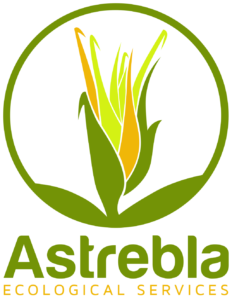In 2018 Simon was privileged to work on a broad range of projects on sites in the Northern Territory, Queensland and New South Wales. Some of this work involved searches for threatened flora species, and in total, 19 threatened plant species were encountered. This included two endangered species, 14 vulnerable species, and three near threatened species. This blog includes some of the highlights!
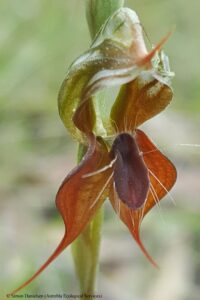
Pterostylis chaetophora (M.A. Clem. & D.L. Jones) Szlach. (Orchidaceae)
Listed as vulnerable in NSW, scattered individuals were recorded from eucalypt grassy open forest along the upper edge of run-on slopes in the Raymond Terrace area, near Newcastle in NSW. The species epithet ‘chaetophora’ means ‘bristle-bearing’ in Greek and refers to the conspicuous hairs on the labellum, clearly visible in the photo on the left. ‘Pterostylis’ means ‘winged style’.
Tylophora rupicola P.I. Forst. (Apocynaceae)
 Listed as endangered in Queensland and under the EPBC Act, this species is a rare slender twining vine distinguished by its small lanceolate, herbaceous, opposite leaves with purplish-red petioles and clear sap. It has been recorded from 16 locations between Cairns and Herberton – the Astrebla records represent a minor southward range extension to the existing collection records. A total of 76 plants were recorded, with one population of 50 plants.
Listed as endangered in Queensland and under the EPBC Act, this species is a rare slender twining vine distinguished by its small lanceolate, herbaceous, opposite leaves with purplish-red petioles and clear sap. It has been recorded from 16 locations between Cairns and Herberton – the Astrebla records represent a minor southward range extension to the existing collection records. A total of 76 plants were recorded, with one population of 50 plants.
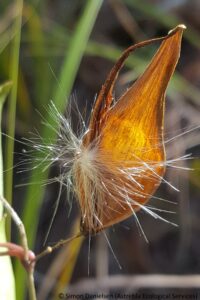 Tylophora rupicola was recorded from low closed and open forests, mostly grassy, on rhyolite slopes in association with Lophostemon confertus, Acacia aulococarpa, Eucalyptus granitica, Corymbia abergiana, E. reducta, Allocasuarina littorlis, Syncarpia glomulifera and C. citriodora, always slightly upslope of rocky minor watercourses (regional ecosystems 7.12.30d and 7.12.66c).
Tylophora rupicola was recorded from low closed and open forests, mostly grassy, on rhyolite slopes in association with Lophostemon confertus, Acacia aulococarpa, Eucalyptus granitica, Corymbia abergiana, E. reducta, Allocasuarina littorlis, Syncarpia glomulifera and C. citriodora, always slightly upslope of rocky minor watercourses (regional ecosystems 7.12.30d and 7.12.66c).
 Dendrobium fellowsii F. Muell. (Orchidaceae) (native damsel orchid)
Dendrobium fellowsii F. Muell. (Orchidaceae) (native damsel orchid)
This is an epiphytic orchid listed as vulnerable in Queensland. It was collected by Astrebla from the Evelyn Tableland, where it was growing on shrubs and trees with rough bark including Syncarpia glomulifera and Allocasuarina torulosa. Dendrobium fellowsii is a Wet Tropics endemic, and was first collected by John Dallachy, described as ‘perhaps the best Australian botanical collector’ by Joseph Maiden (he has at least 14 Queensland plant species named in his honour).
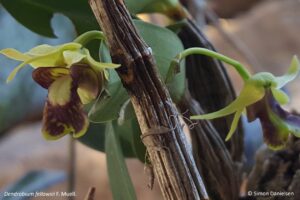 Dallachy collected it in the 1860s from the Cardwell area, and it was described by Baron Ferdinand von Mueller in 1870. Mueller named it after Thomas Howard Fellows, a short-termed Attorney General of colonial Victoria and later a Supreme Court judge. Dendrobium fellowsii is also known as Eleutheroglossum fellowsii (F. Muell.) M.A. Clem. & D.L. Jones.
Dallachy collected it in the 1860s from the Cardwell area, and it was described by Baron Ferdinand von Mueller in 1870. Mueller named it after Thomas Howard Fellows, a short-termed Attorney General of colonial Victoria and later a Supreme Court judge. Dendrobium fellowsii is also known as Eleutheroglossum fellowsii (F. Muell.) M.A. Clem. & D.L. Jones.
 Cajanus mareebensis (S.T. Reynolds & Pedley) Maesen (Fabaceae)
Cajanus mareebensis (S.T. Reynolds & Pedley) Maesen (Fabaceae)
This species was collected from Corymbia clarksoniana grassy low woodland at Arriga, approximately 10 km west of Mareeba. It has been recently de-listed in Queensland and is now listed as endangered only under the EPBC Act.
Tips to ID this relatively poorly documented species include (from Hacker, 1990, A Guide to Herbaceous and Shrub Legumes of Queensland):
- This is the only Queensland species of Cajanus that is a trailing plant with a leaflet length:width ratio of greater than 5:1.
- The lower leaf surface has frequent minute yellow circular resin glands, which are usually conspicuous.
- The stems die back each year but grow to several metres long, and the leaves are well-spaced along the stem (at least the width of the leaflets).
- The leaves are quite large relative to other Fabaceae trailing herbs/vines found in similar habitat – 90-110 x 12-22 mm with a petiole 25-130 mm.
- Pods are strongly flattened, prominently purple-mottled, densely pubescent and with yellow glands on the surface.
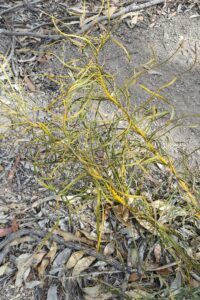 Macrozamia conferta (D.L. Jones & P.I. Forster)
Macrozamia conferta (D.L. Jones & P.I. Forster)
This species is listed as vulnerable in Queensland and under the EPBC Act. It was collected from freehold land near Durikai State Forest, approximately 40 km south west of Warwick, where it was relatively common within small areas. It was present in Eucalyptus sideroxylon and E. fibrosa subsp. nubila open forest on land zone 11 on a flat beside a small drainage line (RE 13.11.5), and E. dealbata low open forest with E. caleyi and Callitris endlicheri on the mid slope of a steep hill (RE 13.11.3). 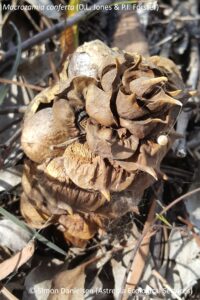
Macrozamia conferta has a subterraenean trunk and leaves with a tightly spiral-twisted rachis. Leaflets are curved upward laterally into a clear ‘U’ shape (incurved). New growth was grey and pubescent. Over 50 individuals were present at each site within an area of less than 5000 m2. The image on the left is of a female cone.
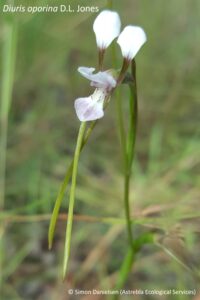 Diuris oporina D.L. Jones (Orchidaceae)
Diuris oporina D.L. Jones (Orchidaceae)
Diuris oporina is a relatively dainty, near threatened orchid collected from open forest and open woodland dominated by Corymbia citriodora and Eucalyptus portuensis (RE 7.12.30) in stony (rhyolitic) clay loam on the Evelyn Tableland in north Queensland. It was always associated with a grassy ground layer dominated by Themeda triandra. Astrebla counted 25 individuals from two populations.
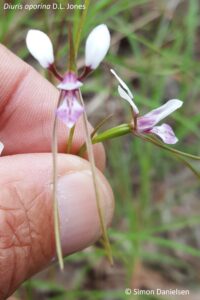 Diuris oporina has until recently been thought to be restricted to the drier western ranges of the Atherton and Evelyn Tablelands in North Queensland. However, material collected as far back as 1953 (and apparently only identified recently) indicates this species has also been found in ranges in the vicinity of Airlie Beach and the Eungella Tableland, and from the Central Highlands in sandstone ranges of the Carnarvon Gorge and Palmgrove National Parks. These are significant range extensions, and indicate that much is yet to be learnt about this beautiful orchid.
Diuris oporina has until recently been thought to be restricted to the drier western ranges of the Atherton and Evelyn Tablelands in North Queensland. However, material collected as far back as 1953 (and apparently only identified recently) indicates this species has also been found in ranges in the vicinity of Airlie Beach and the Eungella Tableland, and from the Central Highlands in sandstone ranges of the Carnarvon Gorge and Palmgrove National Parks. These are significant range extensions, and indicate that much is yet to be learnt about this beautiful orchid.
 Cycas armstrongii Miq. (Cycadaceae)
Cycas armstrongii Miq. (Cycadaceae)
Cycas armstrongii is a cycad listed as vulnerable in the Northern Territory. It is relatively common in the Darwin region. Over 10, 000 plants were recorded within a few hectares in the population survey!
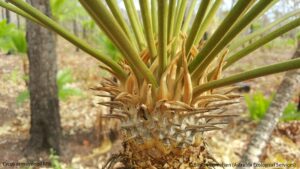 This cycad is relatively easily identified as it has flat to recurved (not revolute) leaflet margins, ovoid-globose pollen (male) cones and densely orange tomentose, pungent cataphylls (illustrated in the lower image – cataphylls are the young leaves). The mature adult leaf blades are green and shiny.
This cycad is relatively easily identified as it has flat to recurved (not revolute) leaflet margins, ovoid-globose pollen (male) cones and densely orange tomentose, pungent cataphylls (illustrated in the lower image – cataphylls are the young leaves). The mature adult leaf blades are green and shiny.
This species was named by the pre-eminent Dutch botanist Friedrich Miquel in 1868, just a few years before his death. Cycas armstrongii was named in honour of John Armstrong, a Kew Gardens botanical collector who had established a government garden at Port Essington in the 1840s.
Port Essington was an early attempt by the British government at settlement of the northern Australian coast, and is located approximately 200 km north east of Darwin. It is perhaps most famous as the terminus of Ludwig Leichhardt’s incredible expedition from near Dalby on the Darling Downs in Queensland, a journey of 4800 km through the (then) trackless interior of Queensland via Cape York Peninsula. Leichhardt arrived in Pt Essington on 17 December, 1945, after a journey of 14 months – surely one of the most incredible feats in Australia’s exploration history! You can now follow Leichhardt’s journey from a new interactive webpage at: http://adb.anu.edu.au/entity/8843
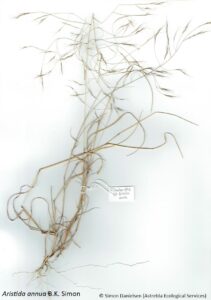 Aristida annua B.K. Simon (Poaceae)
Aristida annua B.K. Simon (Poaceae)
This grass species is listed as vulnerable in Queensland and under the EPBC Act. It is a distinctive Aristida that is easily identified as it is the only annual of this genus with a convolute lemma and an open panicle. It was collected in the Minerva Hills, approximately 18 km north-west of Springsure in central Queensland, growing in black cracking clay with abundant basalt cobble in a Eucalyptus crebra low woodland.
It was immediately obvious that it was an unusual Aristida – the leafy section of the culms was only 20 cm long, the leaves were sparse (suggesting an annual), and the spikelets were noticeably small. The inflorescence was open, to 50 cm long by 20 cm wide.
Aristida annua was described in 1984 by the prolific Queensland grass taxonomist Bryan Simon, and to date is only known from 9 collections. It appears to be very rare, even locally – despite numerous Biocondition surveys conducted across black soil plains, rises and hillslopes in the immediate region over five days that week, this was the only plant observed.
 Homoranthus porteri (C.T. White) Craven & S.R. Jones (Myrtaceae)
Homoranthus porteri (C.T. White) Craven & S.R. Jones (Myrtaceae)
This species is listed as vulnerable in Queensland and under the EPBC Act. It is a shrub to two metres tall with opposite, closely spaced leaves to 10 x 1.5 mm and flowers usually growing in pairs with red/creamy bracteoles and a lobed yellow calyx.
It was collected from rhyolite rock pavement on the Evelyn Tableland, where it occurs as a dominant to sub-dominant component of low heathland, shrubland and low woodland in association with Eucalyptus lockyeri, E. shirleyii, Corymbia abergiana, Grevillea pteridofolia, Allocasuarina inophloia, Acacia aulococarpa and A. leptostachya (comprising generally mixed polygons of REs 7.12.57c, 7.12.65a and 7.12.65k).
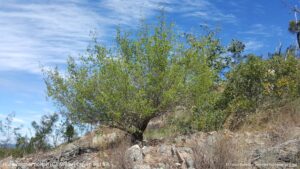 Homoranthus porteri is restricted to upland areas of rock pavement in ranges along the western fringe of the Atherton Tableland, with outlying populations at Mt Windsor (inland from the Daintree River), Mt Mulligan and the Hann Tableland.
Homoranthus porteri is restricted to upland areas of rock pavement in ranges along the western fringe of the Atherton Tableland, with outlying populations at Mt Windsor (inland from the Daintree River), Mt Mulligan and the Hann Tableland.
 Simon Danielsen is a recognised ‘suitably qualified person’ under the Queensland Nature Conservation (Wildlife Management) Regulation 2006 to conduct protected plant surveys, and has conducted over 30 such surveys under the Protected Plant Survey Guidelines to date.
Simon Danielsen is a recognised ‘suitably qualified person’ under the Queensland Nature Conservation (Wildlife Management) Regulation 2006 to conduct protected plant surveys, and has conducted over 30 such surveys under the Protected Plant Survey Guidelines to date.
In addition, he has been approved as suitably qualified to conduct terrestrial ecological surveys under the Environment Protection and Biodiversity Conservation Act 1999.
He has also been approved to conduct surveys for threatened species in the Northern Territory, and has been involved in threatened species searches in NSW.
If you wish to discuss your threatened plant survey requirements, or to determine if a survey is necessary, please contact Simon on 0423 706440 or at simon@astrebla.com.

